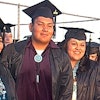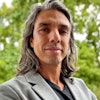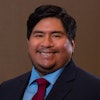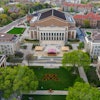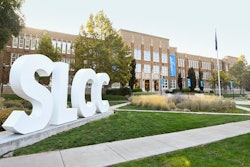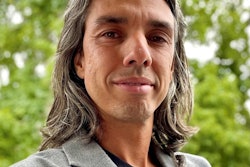 Dr. Donald Lindberg, director of the National Medical Library, Cynthia Lindquist, President of Cankdeska Cikana Community College and Albert Red Bear, Jr. (Courtesy of Mary Annette Pember, ICTMN)
Dr. Donald Lindberg, director of the National Medical Library, Cynthia Lindquist, President of Cankdeska Cikana Community College and Albert Red Bear, Jr. (Courtesy of Mary Annette Pember, ICTMN)
When representatives of the National Library of Medicine, a tiny unit of the federal government’s massive National Institutes of Health in Bethesda, Md., began an education program several years ago to help residents of indigenous communities improve their access to health care information and resources, they found a surprise along the way. Indigenous communities — from Hawaii to Alaska to the lower 48 states — could teach them a thing or two about health, illness and healing.
In October, the library debuted a two-year exhibition called “Native Voices: Native Peoples’ Concepts of Health and Illness.” The high-tech presentation — much of which is set to be available on the library’s website (www.nlm.nih.gov/nativevoices/) — uses pictures, paintings, artifacts and interviews to shed light on the indigenous community’s concepts and practices of health and healing based on meditation, the environment and natural foods.
Library officials declined to put a specific price tag on the exhibition, noting much of it was absorbed by various departments through staff time, and other costs were minimized by pursuing no-cost loans for artifacts and other items in the presentation.
“About halfway through these visits, we said, ‘We’re trying to help them (indigenous communities), they can help us,’ ” says Dr. Donald A. B. Lindberg, director of the National Library of Medicine and the driving force behind the exhibition. “So central to it all is health and ideas. We didn’t intend to homogenize the groups. But there were some things in common,” says Lindberg.
For one, he says, “we found across the three groups (Hawaiian, Native Alaskans and Native Americans in the lower 48 states) [that] they had the idea that you are responsible for your health.” Not so different from the theme among nonindigenous people, he notes.
The focus on indigenous health concepts comes as indigenous and Native communities continue to wrestle with major health challenges. According to the federal government’s National Health Statistics Report of 2010, non-Hispanic American Indian or Alaskan Native communities have higher rates of “risky behaviors, poorer health status and health conditions, and lower utilization of health services” than other racial and ethnic groups. These communities have higher death rates from tuberculosis, accidents, diabetes, chronic liver disease, pneumonia, suicide and homicide than other racial and ethnic groups.
Another common theme, Lindberg says, was people in indigenous communities “found it hard to imagine a healthy person outside a healthy community,” a key reason why many indigenous communities place a high value on water, herbs, spices and other natural foods.
The NLM staff, which spent approximately six years putting the exhibition together, secured artifacts and images from numerous Native nations, organizations and individuals. Staffers also interviewed more than 70 people about concepts of health, illness and healing.
Library officials have not decided whether “Native Voices” will become a traveling exhibition after its two-year run at its headquarters, as some exhibits have been in the past. They note many of the objects in the “Native Voices” presentation are on loan from numerous entities and individuals from around the country.
Today, visitors are welcomed to the library grounds by a colorfully painted 20-foot ceremonial totem, made of a section
of a 500-year-old cedar tree. Positioned in the well-landscaped garden just outside the library, the totem symbolizes the sky, earth, and water and “… the creative power and wisdom of women as leaders and healers,” according to exhibit researchers.
Once inside the library, visitors get an opportunity to see a high-tech multimedia and traditional exhibition housed in approximately 4,000 square feet of the lobby rotunda. Visitors are able to hear and read about Native concepts of health, illness and healing dating back centuries.
Visitors can then go to iPad stations featuring interviews with indigenous people discussing a wide variety of topics dealing with Native concepts about health, illness and healing. Across the room, visitors can use a touch-screen timeline to explore health and healing “highlights and themes” by geographic region and dating to “antiquity.” They can also view a wall of photographs and monitors that provide short interviews with people describing current and past practices.
Around the room are paintings depicting ceremonial activities built around health and healing and exhibits filled with artifacts including drums, pipes, and rattles tied to healing ceremonies in the upper Plains.
Other displays include a stethoscope with elaborate beading and a mortar and pestle used for preparing herbs and other substances thought to have healing powers.
The exhibition “showcases the very modern concepts in various periods of time of how people lived in the environment around them and how they produced and harvested the things around them,” says Dr. Cynthia Lindquist, president of Cankdeska Cikana Community College, the community college serving the Spirit Lake Dakota Nation in Fort Totten, N.D.
Lindquist, who serves on the library’s exhibition advisory council, says the exhibition has “broad implications” for many things today and is a valuable tool for educating the public about native health concepts and practices.
It also says “hello” to the American public, she adds. “We’re still alive and well and still thriving despite colonization attempts,” says Lindquist, referring to past systematic efforts by early settlers and the U.S. government to drive tribes from their lands and “civilize” indigenous communities.
“To have my students go there (to the exhibition) reinforces for them … our culture and what we have to offer the world, this country,” says Lindquist, whose roots in indigenous health education date to her work with the Indian Health Service.
To expand its reach to educators, students and the general public, the library has made a substantial part of the exhibition accessible online. Efforts are underway to make the majority of the video presentations available online next year. A blog about the 4,000-mile journey of the healing totem is only available online.
“We’re trying to share practices that are useful,” says Lindberg.

